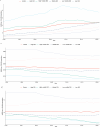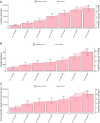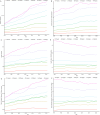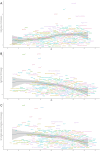Global, regional, and national burden of thyroid cancer in women of child-bearing age, 1990 to 2021 and predictions to 2035: An analysis of the global burden of disease study 2021
- PMID: 40655400
- PMCID: PMC12245710
- DOI: 10.3389/fendo.2025.1555841
Global, regional, and national burden of thyroid cancer in women of child-bearing age, 1990 to 2021 and predictions to 2035: An analysis of the global burden of disease study 2021
Abstract
Background: Thyroid cancer has increased globally, particularly among young women, highlighting the need for research on its epidemiological characteristics and disease burden in women of child-bearing age. This study aimed to analyze the global and regional burden of thyroid cancer from 1990 to 2021, focusing on women of child-bearing age, and to predict trends up to 2035.
Methods: This study analyzed the global and regional burden of thyroid cancer from 1990 to 2021, focusing on women of child-bearing age, using data from the Global Burden of Disease Study. Key indicators assessed included incidence, mortality, and disability-adjusted life years (DALYs) of thyroid cancer in different regions. Statistical analysis techniques were employed to compare the burden across regions and countries, examining the effects of age, sex, and socio-demographic index (SDI) on disease burden. The Bayesian Age-Period-Cohort model was used to predict the incidence, mortality, and DALYs of thyroid cancer from 2022 to 2035.
Results: Globally, in 2021, there were 67,558 new cases of thyroid cancer among women of child-bearing age, with 3,260 deaths and 206,508 DALYs. Compared to 1990, new cases increased by 156.86%, deaths increased by 52.33%, and DALYs increased by 61.72%. The age-standardized incidence rate (ASIR), mortality rate (ASMR), and DALYs rate (ASDR) per 100,000 population were 3.37, 0.16, and 10.38, respectively. The Estimated Annual Percentage Change (EAPC) for ASIR was 1.47, indicating an increasing trend, whereas the EAPCs for ASMR and ASDR were -0.35 and -0.05, showing decreasing trends. The burden of thyroid cancer among patients with women of child-bearing age exhibited a significant age-related trend, peaking in the 45-49 age group. There were significant regional and national variations in thyroid cancer burden, which are closely related to the SDI. By 2035, a notable increase in the incidence, mortality, and DALYs associated with thyroid cancer among women of child-bearing age has been predicted globally.
Conclusion: Over the past 30 years, thyroid cancer incidence among women has significantly increased globally, with slightly declining mortality and DALYs rates. Significant regional and national variations are closely linked to the SDI. As the population ages and incidence continues to rise, targeted prevention and treatment strategies, particularly in low SDI regions, are crucial to effectively reduce mortality and DALYs.
Keywords: DALYs; global burden of disease; incidence; socio-demographic index; thyroid cancer; trend prediction; women of child-bearing age.
Copyright © 2025 Jiang, Bin, Liu, Gao and Liu.
Conflict of interest statement
The authors declare that the research was conducted in the absence of any commercial or financial relationships that could be construed as a potential conflict of interest.
Figures








Similar articles
-
Global, regional, and national burden of maternal disorders, 1990-2021: a systematic analysis from the global burden of disease study 2021.BMC Public Health. 2025 Jul 29;25(1):2576. doi: 10.1186/s12889-025-23814-w. BMC Public Health. 2025. PMID: 40730990 Free PMC article.
-
The Evolving Global Burden of Young-Onset Parkinson's Disease (1990-2021): Regional, Gender, and Age Disparities in the Context of Rising Incidence and Declining Mortality.Brain Behav. 2025 Jul;15(7):e70659. doi: 10.1002/brb3.70659. Brain Behav. 2025. PMID: 40619986 Free PMC article.
-
Global trends in the burden of alcohol use disorders in the working-age population from 1990 to 2021 and projections for the next 20 years.Front Public Health. 2025 Jul 28;13:1616343. doi: 10.3389/fpubh.2025.1616343. eCollection 2025. Front Public Health. 2025. PMID: 40791621 Free PMC article.
-
Global burden and risk factors of musculoskeletal disorders among adolescents and young adults in 204 countries and territories, 1990-2019.Autoimmun Rev. 2023 Aug;22(8):103361. doi: 10.1016/j.autrev.2023.103361. Epub 2023 May 23. Autoimmun Rev. 2023. PMID: 37230312 Review.
-
Burden of inflammatory bowel disease among elderly, 1990-2019: A systematic analysis based on the global burden of disease study 2019.Autoimmun Rev. 2025 Jan 31;24(2):103708. doi: 10.1016/j.autrev.2024.103708. Epub 2024 Nov 23. Autoimmun Rev. 2025. PMID: 39586389
References
MeSH terms
LinkOut - more resources
Full Text Sources
Medical
Research Materials
Miscellaneous

